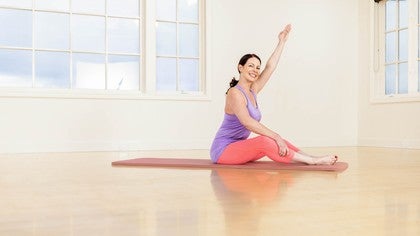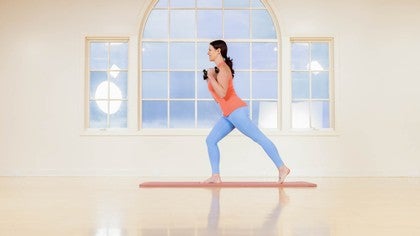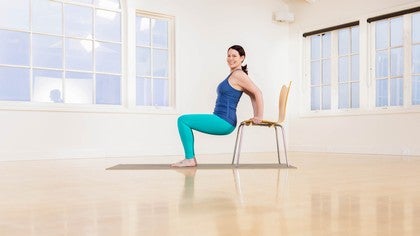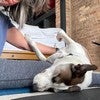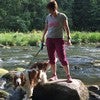Description
About This Video
Transcript
Read Full Transcript
I'm Erin Wilson. And today's class will be focusing on whole body strengthening exercises. We'll be using a chair preferably without arms. Your chair will slide around in many of these exercises if it is not on a mat or a sticky surface or positioned against a wall or a heavy piece of furniture. So make sure you put that in place.
So let's begin by standing at the back of our chair and we're basically using it as something to hold onto. So if you have pretty good balance, you might find that you don't need the back of your chair at all for these first two exercises. So looking down at our feet, we'll place them about sit bone distance apart, which is usually about the width of your fist give or take. And we wanna try to spread our toes out into our mat. Hands are just resting on the back of our chair.
You might find that you'll use more of the chair to help you balance once we get going. So start shifting your weight towards your toes so that they are now heavier than your heels. And then as your heels start to lift up, can we give the glutes just a little squeeze together? And as we lower our heels down, can we think of resisting the way back down to the mat? We'll do that again.
So our body weight's gonna stay forward as the heels lift. Our body weight's gonna stay slightly forward as they lower down. Things to check out as we're rising up and down through our feet. A lot of times the ankles like to roll outwardly the higher up we get on our toes. So if you notice that's happening for you, see if you can roll them in slightly or just feel more pressure on the big toe joints.
If you have bunions though, that might not be comfortable. So do as much of that as you think you can, but not in the causing pain kind of realm there, right? I've got a couple myself, so sometimes they are not very comfortable when I put too much pressure on them. We'll give ourselves about three more of these. Don't feel like you have to go up super high.
Again, those ankle joints wanna roll out. It's not worth it. And we're just waking up the backs of our legs. One more time, we go up. One more time, we come down.
We're gonna take that right into a stretch. So hands can continue to rest on our chair. We'll step back with one leg. We wanna try to maintain the feet parallel. A lot of times the back foot immediately wants to turn out 'cause it's easier to stretch that way.
So it's worth it to look down and make sure your back foot is still pointing straight ahead and the heel can be heavy on the floor. If you're not feeling a lot of stretch quite yet, maybe move your leg back a bit further or start bending your front knee a bit deeper. So the idea is to really press down on the back heel, keep that knee straight. And if we wanna maybe an extra hip stretch in the front, we'll take our hands on the chair and kind of push away from it. And that's gonna let our upper body lean back.
So a little two for one action could be going on here. I got the calf stretch, my calves are generally tight. Always gonna feel that in my body. If you don't have tight calves, you might be feeling more of the hip stretch here in the front of the leg. If you're leaning back, let's take our weight forward, let's peel the back foot off the mat, place that guy underneath our hip.
Step back with your other foot where it lands might be just fine. Make those adjustments, look down. Right, if you have a tighter leg than the other, which we all do usually, that foot might be the one that wants to turn out more. Same thing as before, if I'm not feeling a big stretch yet, slide the foot back a little further, bend the front knee a little deeper. And if we wanna go for that additional hip stretch, we'll push away from the chair.
And it's just a small leaning back, but you could try to breathe in. Might even be a nice way to stretch out the lower abdominal muscles. That's usually tighter areas well in our bodies. If you're leaning back, we'll come forward towards our front leg is an easier way to get out of there and we'll step that foot together. Last thing we're gonna do, mobilizing our joints, is to get into the inner thigh muscles and get a little bit deeper into the hip joints.
So we're using our chair once again just as something to hold onto, if you don't need to, balance is fine today, feel free to just put your hands on your pelvis. So we'll come into a small V, stay fairly close to the chair, we'll take a step out to the side. We're gonna bend that knee and then send your pelvis back. Now the lower your chest gets to the floor and the further your pelvis is going back, usually the bigger the stretch is on the straight leg. You could also plan with turning this foot out or even turning it more in, if you're not feeling too much there.
If none of those work, you might not be tight in that part of your body so that's fine. We're gonna come out of that one and then we can turn around the other way. Or if you have enough room next to your chair, we're just gonna bend our opposite knee, go towards the chair. Same thing, push your pelvis back. The flatter our back is the more we're gonna feel the stretch, if there's a stretch to be felt in the opposite leg.
All right, we're coming all the way back up. We'll do that one more time to each side and then hopefully we're ready to go and get into some of the strengthening exercises on the chair. So here we are. One more stretch on the first leg, and we'll come back up. And then one more time, bend the second knee.
Really push your butt back if you're not feeling too much. It's a nice way to hopefully get some more connection there. And then we'll stand up all the way. All right, we are gonna be sitting in our chair next. So depending on the width of your chair and the width of me, I'm gonna determine where I need to sit in order to be able to stand up and sit down in a pretty brisk pace.
So if our feet are in a width, that would naturally feel good for us to stand up and feel like we have control and strength there, that's where we're gonna put our legs. Generally speaking, shoulder width apart, maybe a little bit of a turnout in the feet. Come towards the front edge of your chair. This is where you might need to hold onto something, but we're gonna lean forward. So we're in that hip hinge position.
And as we're ready to stand up, we just wanna see what that feels like. Pretty easy usually. But as we sit back down, that could be a little less familiar feeling or that might be where we're a little unsteady. So we're gonna stand up. We do this all day long.
But generally speaking, when we go to sit down, sometimes we put our hands down on the arms of the chair or I'm looking behind me, or it's a couch, you don't have to really worry about making it. Okay, my chair's pretty narrow, so again, if you're working with a narrower chair, maybe every once in a while look back, just make sure that you know that you're sitting on it well. Next phase is gonna be to add a little bit of a hop or a little bit of a jump to this. So if sitting and standing is where you're at today, continue doing this movement. Otherwise, we're gonna add a little bit of a jump every time we stand up.
Pump the arms or feel free to just keep your hands on your pelvis. So let's hinge forward. As we stand, we're gonna jump. As we land, we're going to sit. Let's try one, here we go.
Up and sit. And up and sit. If that feels safe, great. If you know jumping is not a good thing for your joints at the moment or even just today, knees are feeling weird, just continue with the squats. Hey, if we are jumping and I have bare feet, I really wanna feel my feet rolling through.
So heels up to the toes, toes back to the heels. You wanna be conscious of that even if you have shoes on. Let's give ourselves five more. If you're doing the regular squats, it might be a little slower right now than the jump. And we're going for two.
And we'll get one more right here. All right, staying on our chair. The next exercise, again, the depth of your chair might make a difference as far as where your hands should be positioned. So move around. We're gonna walk our feet more forward.
Try to sit right on the edge of the seat. This can be a little tricky feeling initially. And then if you have tight shoulders, the chair might not be the exercise for you today for this particular exercise. This can be done on the floor. You could even go to a wall and do some wall presses with your elbows pointing down, right?
So make sure it works best for your shoulders first. We're gonna wrap around the sides of the seat, palm's facing in, and then as we bend our elbows, we wanna make sure that we can lean back. And the elbows, if they're hitting your chair right away, you might wanna come a little more forward. Or again, the chair might not work for you today, come to the floor. If we can get our butt off the seat, we're gonna walk our hands a little bit closer to the front.
We'll slide our pelvis off the chair, and we just wanna make sure that our back is straight up and down. It's really easy to tuck. It's a little bit better that way, so feel free. But if we can, we wanna drop the tailbone and sit bones down to the floor. From here we're gonna bend our elbows and we're gonna press ourselves up.
So just a chair dip, tricep dips. And the deeper you go down, obviously it's harder to get back up. Make sure it doesn't feel strenuous to your shoulders. Might feel like a little stretch, but if it's anything beyond that, not worth it. Let's go ahead and take three more like this.
And we'll go for two. If you need a hand break, sit on the chair, take a moment. If we wanna add on, continue doing these, or walk your feet a little closer together, bend our elbows, and as we straighten them up, we're gonna kick one leg out, put our foot down, bend them again, kick the other leg. So now we're just up in the ante. How much more weight can we put on our arms?
And we're also building some more coordination. We'll do two more on each side. Stop anytime and push one more on each side. And last one here. Okay, put your foot down, have a seat, and then just let your wrist flex over the other way.
You could even press down on one, press down on the other. Shake out our arms a bit. Standing up from there, we'll turn to face the chair. And then we wanna figure out where we should be, depending on if we're gonna pick up the chair or not. So if our chair is light enough or a good weight for us to lift it up with, go ahead and try these.
If the chair's a little too heavy or a little too awkward, feel free to pretend like you're picking the chair up instead. So we wanna find our squat stance. Send our pelvis back. As we bend our knees, we're gonna reach and grab the chair. This is where I'm gonna option to pick it up as I stand.
Stick our butt out again, put the chair down, leave it down there and stand again. So if that's a good option for you, stick with that. If not, grab the chair, pretend like you're gonna pick it up, don't, and then come back up again. Here we go. Pelvis goes back, knees bend, grab the chair.
As I lift it, can I pull my abs in a little bit. As I put it down, keep pulling my abs in and then let it go and stand. Sit back, bend the knees, grab the chair, abs pull in as we stand up. Keep pulling them in to put the chair down and up we go. So 'cause the chair's a little bit out in front of us, right?
This is a really good functional movement 'cause how many objects are directly in between my legs when I go to pick them up? Not too much, right? So generally speaking, we're reaching out a bit whenever we lift up an object. And that can be very challenging for the back. So we wanna pull our stomach muscles in as soon as we pick up the chair and give our back some support that it needs from the front of the body as well.
Let's give ourselves three more here and up. Stick your butt out every time. It's my mantra for life. And we go two more. And lift and sit back.
One more time, if we've got the stamina for it. Bring it up, put it down, and we'll leave it right there. Okay. If your chair has a hard surface, some of these next exercises might be as not as comfortable for your forearms, for your elbows, so if that's the case, you get into the position and you find that it's really bothersome for your arms, you can drape a towel or anything kind of thin like a blanket as long as it feels safe, go ahead and drape that over your seat. I feel fine on this chair personally.
So I'm gonna opt to not do that. So we're gonna be coming down. And again, this is where the width of the chair might make a difference. All of these exercises can be done on the floor or against the wall. I have the the option on this chair to wrap my hands around the back of it.
So if that is your chair set up, feel free to do that as well. And the further back you are away from the chair, the harder and harder this exercise has become. So we're gonna keep walking back if we can into a full plank. And then just feel your position for a few moments. Ideally, your pelvis is in line with the top of your shoulders on a low diagonal.
We're trying to avoid sinking our pelvis down. So we'll hold it here. All the movement is going to happen from our shoulder joints. So as we push into our arms and push away from the chair, our pelvis will pike up. As we pull ourselves forward, we're gonna pause when our shoulders are more or less under our elbows and we're in that long line again.
So push away from the seat, pike your pelvis up, pull yourself forward, find your long plank. If the legs are closer together, sometimes that's easier, 'cause you can use the strength from your inner thigh muscles squeezing together. But that might feel a little more challenging if you have tighter hamstrings. So feel free to separate your feet wider if that allows your knees to stay straighter throughout the movement. We're gonna give ourselves two more here.
So we breathe to push away and breathe to pull ourselves forward. And just one more time, breathe to push away. And one more time we come forward. From here, we're gonna walk our feet towards the chair. And just come up, shake your arms off for a few seconds.
You have the option to be on your forearms again for the next exercise. Otherwise we're gonna attempt to wrap our hands around the seat of the chair. If your wrists say don't do that, this can definitely be on the forearms. Again, all of these can be done on the floor or also against the wall. So we'll wrap our hands around the sides of the chair.
Same thing as the last exercise, the closer my feet out of the seat easier. If I keep going further back this way into our long plank, this is gonna be the most challenging setup. So imagine pulling yourself slightly forward towards the chair and as we're gonna hold this shape, we'll begin to bring our right knee in. It might tap the edge of the seat, it might not make it that far, that's okay. Really stretch back into your left leg and then we'll step the right leg back.
Left leg, same thing. It might tap the chair, it might not. And step back. So whatever leg is coming forward, we wanna really reach back into the opposite leg. We wanna keep feeling some good length behind the back of our neck, so it might be worth it to take your eyes more towards the back rest of your chair versus right down in between your hands.
Okay, this position can usually round our upper back too much. and your head weight is a lot, so don't just let it hang out down there on its own. Let's go three more to each side. Holding our arms strong. Three.
We're gonna go for two. And two, upper bodies not changing at all. One, and one. And we'll walk our feet forward again. Take our hands off of the chair and shake those arms out.
We'll be using the back of our chair again for some balance. It's also a nice way to work in to a split squat position. This is one of the many ways that we can get ourselves up and down off of the floor. So with any kind of squat or any kind of lunge type position, we run the risk, if you have knee issues of exacerbating those issues potentially. So let the first one or two tell you if this is a good idea or not.
And you always have the option of not going very low with the knee bent. So we're gonna step back with our right leg. Find a lunge. Whatever's comfortable for you. It could be very close.
It could be way back here. We're all gonna look different. We want the front leg. They need to be right over the mid part of our foot regardless though, so not too far forward, but also not behind our heel. So try to figure out where that angle is and where that angle allows your back leg to be.
Pelvis is pointing straight ahead. Shoulders are straight ahead. As soon as we bend our back knee, we don't wanna tuck, right? And lean back like that. It's gonna throw a lot of excessive force into the back knee joint.
Instead, think of just barely sticking your butt back. Bring the knee down. If you have toe flexibility issues, that might be the thing that holds you back from getting down that low. No problem. Don't have to come all the way to the floor, straighten the back leg.
If we can, let's try to come down to the floor. So we'll bend our knees low as it feels safe to go, straighten it up. Other things to look out for. The lower we go, right? The more challenging it is to keep our pelvis more level.
So we're attempting to keep both pelvic bones fairly straight across. Because one leg is behind us, that pelvic bone is naturally gonna be a little bit lower. But when we bend our knee, we don't necessarily need the front pelvic bone to hike up like crazy at the same time. So just keeping that small ratio as we go down and up. That's mostly what we're looking for.
And these are not usually easy exercises, so if you're fatiguing out fairly quickly, you are not alone. Check your front knee out every now and then. Make sure that it's still pointing directly over the middle part of that foot. Let's go for two more here, and this will be our last one. And I don't know about you, but I'm very glad the chair was here right now for those exercises.
Bring your foot forward. Let's set ourselves up for the other side. So different foot in the back, different foot in the front, toes, all that stuff factors in. Check out our front leg. Can the knee be over the mid part of the foot?
Can the back heel stay off the floor the whole time? We'll find out. Lift our chest up, bend the back knee. See where you can go on this side and bring it back up. Maybe this is this side that doesn't want to go that low.
Maybe this is the side that wants to go lower. We will find out sure. All right, straighten it back. Stay tuned now and we extend again. So the front knee of course is bending deeper as the back leg bends, but making sure it doesn't go inward, right?
It's just right over the front of the foot. Lifting up through our heart. Okay and try not to tuck. Yeah, the minute our pelvis goes back, it's like, (imitates squeaking) all of those forces get just too much into the knee joint space. Let's give ourselves four more here.
And we'll go for three. Keep pulling the pelvic bone back of the front leg. Two. And we've got one more. And that's it right there.
All right. So from here we're gonna be trying some pushups using the seat of our chair again. This is another exercise where just because of the width of your chair and maybe the width of your shoulders or other factors, the chair version might not work. So once more, you can come down onto your mat and do kneeling pushups, full plank pushups. You can also again find the wall and go into a nice wide pushup, or a narrow elbow pushup, okay?
The back of the couch works well too if it's heavy enough. So coming down towards our chair, just like the last exercises we did in this position, the closer our feet are to the seat, to the chair itself, the easier it is with the weight bearing on our arms as we bend and straighten our elbows. For most of us, the narrowness of our seat is gonna mean we're doing more of a tricep pushup. So where our elbows are closer to our sides. So let's figure out where we can be in our plank.
If you're going for a full plank that's the hardest. And then as we bend and straighten our elbows, the back of the chair is very close to you. You might need to not go as deep or maybe come more towards the front edge of the seat with your hands, but not so where it's gonna be unsafe. So feel your long line. And as we bend our elbows, we're gonna try to hug them close to our sides.
And when we're ready to push up, hold yourself there. So again, we'll bend our elbows, and push away. It could be an inch that we're bending them, it could be five, and push. The thought is to pull yourself forward a bit every time we bend our arms. Let's go for four more here.
Lifting up through our abs. If the legs are closer together, squeeze through your upper inner thighs and feel a little bit of a pelvic tuck perhaps. And we'll bend two. And one more time, push away and we'll walk forward again. The next series of exercises, we're going to be putting our feet on the seat of our chair.
So if you need a pillow or anything else to help support the back of your head and neck, we will be laying down. Go ahead and organize that for yourself right now. So make your way down onto the mat. And this is another position where the chair will definitely slide if it's not on something sticky or against a wall or an object. So figuring out where we need to be in relationship to the chair is different for all of us.
So ideally, we're looking for our knees to be right above our hips, and we have this full 90 degree angle that's present. If we can hook our heels over the edge of the chair, that's gonna be our first starting position. We'll go into another position after that. But if this just feels too slippery, the next position we'll do either way is to put our heels on the top part of the seat of our chair. So for now, if we can hook our heels over the edge, have our foot wrap over the chair.
We're gonna press down very actively into our arms. And think of pushing down on the chair and also slightly pulling it towards you to bring your pelvis up. From here, we're just gonna lower straight down, No articulation through the back. Again, press down on the chair, pull it a little bit towards you as your pelvis and back come up. And then just straight down we go.
Automatically, you might feel your hamstrings cramp up on an exercise like this. There's a lot of load we're putting on those muscles. So if you keep getting the hamstring cramps and just can't get out of them, put your feet on the floor just underneath your chair if you have the room, and just do a basic bridge down there. Let's go ahead and do a few more like this. And as we're pushing down onto the seat, again try to feel the pressure where your feet are at.
Lot of times one leg is gonna wanna do more and we get higher and higher up in the bridge. Because the feet are so high up, it's harder to connect to the glutes. So make sure that you are still feeling as though you're trying to squeeze your glutes together every time we get to the top. Take a moment down here, we're just gonna straighten our legs out. Let your calves rest on the chair for a moment.
Moving into the next position, very hamstring specific. So if you're already getting cramps by having your feet hooked over the edge of the chair, this next part of the exercise, it might cramp up even more. So feel free to stay where you're at, or again, put your feet down on the mat. We're gonna flex our ankles. Got our feet about pelvic width apart, maybe a little narrower if you want more of a challenge.
The backs of our heels are pressing down already. On the seat of our chair, make sure you're not right on the edge, the chair could tip towards you, not cool. So err on the side of being more on the actual seat. So as we push down with our heels, same thought, we're lifting straight up. And if we really wanna go for it, we're gonna drag our heels towards our butt energetically every time we lift.
Lower your pelvis straight down and we do it again. So we push down on the backs of our heels. As we lift up, we think of pulling them towards our butt, and then we lower our pelvis down. If you don't do the heel pull thing, odds are you're getting plenty of work already without it. And drop back down.
So sometimes this can activate the muscles around our knees in a negative way. So if you're feeling any negative tension around the knee joints, go back to hooking your foot over the edge of the chair. Or go ahead and place your feet down on the mat. Let's give ourselves three more here. Still squeeze the glutes.
Still think of squeezing something in between your knees even though there's nothing there. And again, dragging your heels towards you. Real big movement for the hamstring muscles and our calves. Lower down. Once again, we'll straighten our legs out.
Take a few seconds and just let everything rest. So we'll keep one leg on top of the chair. We're gonna grab behind the back of one of our thighs, press it into our hands. Try to straighten the leg up for a few seconds. It definitely does not wanna do that right now.
We're trying. And then see if you can roll your foot and ankle, just a few circles in one direction. Roll your foot and ankle a few circles in the other direction, and we'll place that leg down on the seat. Picking up our other leg, same thing. Push your thigh into your hands a bit.
Try to straighten that leg up. A little more willing, now that time's going on. And then once more, we'll try to circle our foot and ankle around. And we'll go the other way. And when we're ready to let go of our legs here.
we'll just let both rest on top of the seat. Now depending on where your chair is positioned and if it feels too slippery or not to do this, we'll use the chair for a bit of leverage perhaps. We're gonna hook the right foot over the edge of the seat again. We might have to scoot back on this one depending on how tight your hips and glutes are feeling. And we're gonna try to cross our left ankle above the right knee.
So by having the leverage of the seat and kind of rest our footing there, we're gonna think of just dropping our tailbone down into the mat. And just by doing that, hopefully the stretch on the left glute was enhanced. And then if that's still not enough, we'll keep dropping our tailbone down. And then maybe take your left hand and gently push your left knee away from your chest at the same time. Let's give ourselves a few more breaths here, as we worked our glutes and legs quite a bit today.
And then we're ready to back off on that, let your pelvis tuck a little bit just to come out of this side. And then if that works, we'll hook the left heel around the chair. If that doesn't work, you can just do the traditional figure four stretch where we grab on behind the backs of our legs and pull them towards our chest instead. So you might need to back off on this side. This might be the tighter glute.
And then just like we did a moment ago, can we think of dropping our pelvis, dropping our tailbone down into the mat? Okay, as if we're trying to lift our lower back off the floor. It might actually be a little bit off the floor. And if we still need more, we're gonna press the inside of our right knee with our right hand. And hopefully, all the good things are happening.
Two more big breaths, in and out. And we're ready to back off on the pressure of our leg, if we are doing that. We'll uncross our leg either way. Let both legs stretch over the top of the chair. We'll take our arms.
We just drape them behind you for a few moments or out to your sides. Deep breath. And then getting out of this position can be interesting. So two things, we can pull our knees into our chest, and then roll onto our side. You can also place your feet down on the outsides of the chair and kind of walk your way up.
I'm gonna choose to roll off to the side a little bit and come up from there. Thank you so much for joining me today.
Begin Pilates: Functional Practices
Comments
You need to be a subscriber to post a comment.
Please Log In or Create an Account to start your free trial.
